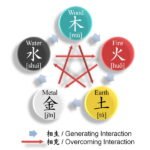Introduction to the Goryeo Dynasty
The Goryeo Dynasty, established in 918 AD by the notable general Wang Geon, marks a significant period in Korean history characterized by its cultural, political, and artistic developments. This dynasty emerged in the aftermath of the tumultuous Late Silla period and sought to unify the Korean Peninsula under a centralized governance structure. The name “Goryeo” itself is derived from the word “Goguryeo,” reflecting its intention to connect with the glorious legacy of this ancient kingdom. Goryeo lasted until 1392, being a pivotal precursor to the subsequent Joseon Dynasty.
During its rule, Goryeo made substantial contributions to the evolution of Korean society. It fostered advancements in governance, promulgating laws and administrative systems that would lay the foundation for future states. These developments are particularly notable given that Goryeo was one of the first dynasties in Korea to adopt a centralized bureaucratic system, allowing for more effective management of its territories and resources. This administrative framework not only enhanced governance but also influenced the political structures during the Joseon era that followed.
Culturally, the Goryeo Dynasty has left an indelible mark, particularly in the realms of art and education. The introduction of celadon pottery, the creation of the Tripitaka Koreana, and the promotion of Confucian ideals played a crucial role in shaping Korean identity and values. Additionally, the dynasty’s focus on Buddhism contributed to the rich tapestry of spiritual and philosophical thought, fostering an environment where art and intellect could flourish. Understanding the Goryeo Dynasty’s achievements is essential for comprehending how these precedents set the stage for the dramatic transformations that would transpire during the Joseon era.
The Foundation and Early Years
The Goryeo Dynasty, which emerged in the 10th century, marked a significant turning point in Korean history. Its foundation can be traced back to Wang Geon, a military leader who successfully unified the Later Three Kingdoms of Korea: Goryeo, Silla, and Baekje. This unification was not merely a military conquest but a strategic effort to create a stable and prosperous state. Wang Geon’s ascension to power in 918 set the stage for Goryeo’s political and cultural advancements.
Initially, Wang Geon faced fierce opposition from rival factions and external threats. However, his adept military strategies and tactical alliances enabled him to consolidate power effectively. One of his key strategies was the strengthening of the Goryeo military, which allowed for successful campaigns against the Khitan Liao Dynasty, a formidable neighbor to the north. The military reforms enacted during these early years focused on enhancing the capabilities of the troops, ensuring that Goryeo could defend its sovereignty and maintain internal stability.
In addition to military focus, Wang Geon placed great emphasis on developing political structures that would support governance across the newly unified territories. A centralized administrative system was established, which facilitated better communication and jurisdiction across the regions. Furthermore, the infusion of Buddhist and Confucian ideals into the governance model helped solidify social order and reinforce loyalty among subjects. Such ideological foundations laid the groundwork for a cultural renaissance in Goryeo, promoting the arts, literature, and education.
The diplomatic relations during these formative years were also pivotal, especially with the Khitan Liao Dynasty. Wang Geon skillfully navigated the complexities of foreign relations, managing both conflict and peace agreements. This diplomatic balancing act not only secured Goryeo’s borders but also fostered trade and cultural exchanges, which significantly contributed to the dynasty’s early economic prosperity.
Cultural Flourishing Under Goryeo
The Goryeo Dynasty, which reigned from 918 to 1392, marked a significant era of cultural advancement in Korean history. This period was characterized by notable achievements in literature, art, and technological innovations, reflecting a flourishing cultural identity that was profoundly influenced by both indigenous traditions and Chinese culture. One of the most prominent literary milestones of this period was the creation of the ‘Tripitaka Koreana.’ This impressive collection of Buddhist scriptures, meticulously carved onto wooden blocks, emerged as a cornerstone of Korean Buddhist scholarship and showcases the dedication to preserving religious and philosophical texts through advanced printing techniques.
Furthermore, the Goryeo era is renowned for its exquisite celadon pottery, which exemplifies both aesthetic beauty and technical skill. The distinctive green glaze of celadon pieces was highly sought after, with intricate designs often depicting nature and Buddhist motifs. This art form not only highlights the mastery of Korean artisans but also reflects the socio-cultural dynamics of the time, infusing everyday life with artistic expression and spiritual significance.
Technological advancements during the Goryeo Dynasty were equally impressive, particularly in the realm of printing and publication. The introduction of movable metal type in the 13th century allowed for more efficient reproduction of texts, paving the way for a broader dissemination of knowledge. This innovation laid the groundwork for future developments in Korean literacy and education, significantly impacting the culture and society.
Moreover, Buddhism played a pivotal role in shaping the cultural identity of the Goryeo people. The religion not only served as a spiritual foundation but also influenced various aspects of daily life, art, and philosophy, intertwining with Confucian and shamanistic traditions. Consequently, the cultural achievements of the Goryeo Dynasty not only reflect its historical context but also provide a glimpse into the formative influences that contributed to the rich tapestry of Korean heritage.
Political Developments and Challenges
The Goryeo Dynasty, which ruled Korea from 918 to 1392, experienced a complex political landscape characterized by internal strife and external threats. Throughout its history, the dynasty faced numerous succession crises that weakened its governance. The struggle for power among royal family members often led to intense conflict, as rival factions attempted to assert their dominance. Following the death of a king, disputes over the rightful heir frequently emerged, which contributed to instability within the ruling elite.
Factional struggles were another significant challenge to the Goryeo Dynasty. Political factions, primarily composed of aristocrats and bureaucrats, vied for influence and resources. These factions not only exacerbated political divisions but also resulted in a lack of unified governance. One prominent faction, the “Pro-Yuan” supporters, aligned themselves with the Mongol Empire, while others favored a more independent stance. This division within the aristocracy detracted from Goryeo’s ability to respond effectively to pressing threats.
Rebellions during the Goryeo period further showcased the growing discontent among various classes of society. Peasant uprisings, fueled by heavy taxation and corruption, were commonplace and often violently suppressed, resulting in further resentment towards ruling authorities. As these internal challenges mounted, external forces, particularly under the growing influence of neighboring powers like the Mongols and the emerging factions within Korea, presented a serious threat to the stability of the Goryeo regime. A significant turning point occurred with the rise of Yi Seong-gye, a military leader who capitalized on the prevailing chaos. His eventual assertion of power signified the profound vulnerabilities that existed within the dynasty, ultimately paving the way for the transition to the Joseon Era.
The Mongol Invasions and Their Impact
The 13th century marked a tumultuous period for the Goryeo Dynasty, primarily characterized by the relentless Mongol invasions. The Mongols, under Genghis Khan and later his successors, sought to expand their territory, leading to multiple military campaigns against Goryeo, which began in 1231. The initial resistance from the Goryeo military, although commendable, ultimately proved insufficient against the Mongolian warfare tactics and superior cavalry forces. Despite some early victories, the Goryeo army faced severe losses, leading to widespread devastation across the Korean Peninsula.
By 1258, the Mongols had installed a puppet regime, exerting significant political control over Goryeo. This era saw the implementation of Mongol administrative practices, which disrupted the traditional governance structures of the Korean nobility. The Mongol rule brought changes that rippled through the socio-economic fabric of Goryeo. The burden of tributes and taxes imposed by the Mongols drained resources, resulting in a decline in agricultural productivity and a deterioration in living standards for the common populace. Trade routes, once flourishing, grew unstable, precipitating economic hardship across the dynasty.
Furthermore, the Mongol invasions altered the balance of power within Goryeo’s aristocracy. The Mongal presence created factions among the ruling elite, some choosing to collaborate with the invaders for personal gain. This led to further fragmentation and internal strife within the dynasty, vitiating the authority of the centralized government. The weakening of the Goryeo state under Mongol domination catalyzed its eventual decline, setting the stage for the emergence of the Joseon Era. The long-term impact of the Mongol invasions thus marks a pivotal shift, influencing both the trajectory of Korean history and the dynamics of East Asian geopolitics.
Rise of the Joseon Dynasty
The transition from the Goryeo to the Joseon Dynasty marked a significant shift in Korean history, characterized by the demise of feudal structures and the emergence of a new political order. Central to this transformation was Yi Seong-gye, a military leader whose actions were instrumental in dismantling the Goryeo Dynasty, which had become increasingly corrupt and ineffective. Yi’s discontent with the ruling elite’s inability to uphold governance and protect the kingdom from external threats fueled his desire for change. His military successes against the Mongols and the subsequent political maneuvering established him as a prominent figure in the movement towards a new regime.
Moreover, the ideological motivations behind the foundation of the Joseon Dynasty were deeply intertwined with Confucian principles. The decline of Goryeo had led to widespread disillusionment among the populace, who yearned for a government that prioritized moral governance and virtuous leadership. The Confucian resurgence during this period provided a philosophical framework that justified Yi Seong-gye’s usurpation of power, as it emphasized the need for a ruler who was in harmony with the people’s needs. This created a fertile ground for establishing a dynasty that sought to embody these values.
Public sentiment toward the Goryeo Dynasty had shifted significantly. As corruption and ineffectiveness dominated Goryeo politics, the hope for renewal and stability emerged as a rallying cry for the masses. The popular support for Yi Seong-gye and his vision for the Joseon Dynasty reflected a collective yearning for a more responsive governance system. In this context, the rise of the Joseon Dynasty symbolized not just a change in leadership, but an opportunity for a fresh start, promising a brighter future built upon principles of justice, morality, and renewed national pride.
Legacy of Goryeo
The Goryeo Dynasty, which ruled Korea from 918 to 1392, has left a profound and enduring legacy that continues to shape the cultural identity, political framework, and societal norms of modern Korea. One of the most significant contributions of the Goryeo period was the establishment of a centralized bureaucratic system, which laid the foundation for the subsequent Joseon Dynasty. This political structure emphasized Confucian ideals, promoting the importance of governance by virtue and merit, a principle that profoundly influenced Korean society in subsequent centuries.
Culturally, Goryeo is often revered for its advancements in various art forms, including ceramics, painting, and literature. The era is particularly noted for the production of exquisite celadon pottery, which exemplified the high artistic standards of the time. These artistic traditions were crucial in shaping the aesthetic values that would later be embraced by the Joseon Dynasty, thereby ensuring the continuity of Korean cultural heritage. Furthermore, the invention of the Korean script, Hangul, which originated in the Joseon period, was deeply rooted in the linguistic territories established by Goryeo scholars. Their contributions to written language paved the way for a more accessible literacy for the general population.
The Goryeo Dynasty also fostered a sense of national identity through the reflection of its unique Buddhist heritage and its promotion of the Korean cultural narrative. The establishment of Goryeo Buddhism not only influenced spiritual practices but also fed into the collective memory of the Korean people, asserting a distinct cultural identity that has persisted through centuries of change. In contemporary Korea, many traditions and practices trace their origins back to the Goryeo era, signifying its pivotal role in shaping the nation’s character.
Thus, the legacy of Goryeo resonates within modern Korean society, demonstrating the dynasty’s lasting impact on the cultural and political fabric that ultimately paved the way for the Joseon era and beyond.
Comparison with Joseon Dynasty
The Goryeo Dynasty, which reigned from 918 to 1392, is often juxtaposed with the subsequent Joseon Dynasty, lasting from 1392 to 1910. A comprehensive comparison reveals significant insights into governance, cultural contributions, and societal transformations that defined both dynasties. The transitions between these two dynasties were deeply rooted in the socio-political failures witnessed in Goryeo, which the Joseon Dynasty sought to address through its policies and practices.
Governance during the Goryeo era was characterized by a central authority that increasingly lost control over regional military leaders, leading to political instability. This fragmentation fostered corruption and weakened the central institution, ultimately paving the way for new governance models. In contrast, the Joseon Dynasty established a centralized bureaucratic system heavily influenced by Confucian principles, aiming to consolidate power and stability. By reinforcing a meritocratic civil service exam system, Joseon sought to minimize the regional disparities that had plagued Goryeo, enhancing administrative efficiency.
Culturally, the Goryeo Dynasty made significant contributions, notably in the realms of art and literature. The invention of movable metal type and the production of the Tripitaka Koreana stand out as remarkable achievements. However, the Joseon Dynasty further advanced these cultural realms, emphasizing Confucian education, which reshaped the social fabric. Joseon’s focus on print culture and scholarship led to the development of new genres of literature and more accessible education for the populace, thus encouraging literacy among the masses.
Societal changes during the Joseon Dynasty were influenced by the Confucianization process, promoting a more rigid societal hierarchy compared to Goryeo. This shift significantly altered family structures, gender roles, and community relations, emphasizing loyalty and filial piety. The lessons learned from Goryeo’s decline informed the manner in which Joseon approached these societal configurations, seeking to cultivate a strong reliance on Confucian values to prevent the disarray experienced by its predecessor.
Conclusion: Reflections on a Dynamic Era
The Goryeo Dynasty represents a significant chapter in Korean history, marked by a complex interplay of political, cultural, and economic transformations. Established in 918, Goryeo maintained authority for several centuries, during which time it developed a unique identity that laid the groundwork for the subsequent Joseon Dynasty. This era was characterized by notable achievements in art, such as celadon pottery, and significant advancements in government structure and societal organization. However, the subsequent decline of the Goryeo Dynasty reveals a narrative of internal strife, external threats, and the ultimate shift in power dynamics that paved the way for the Joseon era. The challenges faced by Goryeo, including conflict with rival states and the Mongol invasions, underscore the vulnerability of even established dynasties in the face of external pressures. Importantly, this period illustrates the fragility of political power and emphasizes the consequences of fragmentation among ruling elites.The lessons from the rise and fall of the Goryeo Dynasty endure in today’s understanding of Korean history, reflective of broader themes such as resilience and adaptation in the face of change. Observing the complexities of this dynasty not only enriches our knowledge of Korea’s past but also invites further exploration into how these historical events shaped the cultural and political landscape leading into the Joseon Dynasty. The narrative of the Goryeo era is essential for comprehending the historical continuity and transformation that characterize Korea. Therefore, a deeper engagement with this dynamic period will undoubtedly yield valuable insights into the legacy of Goryeo and its impact on the overarching historical framework of the Korean Peninsula. As such, continuing to study this era provides a richer appreciation for the complexities and interconnectedness of Korean dynastic history.














